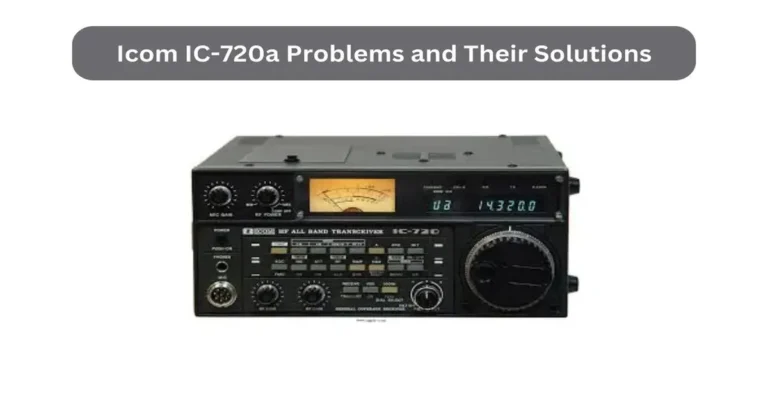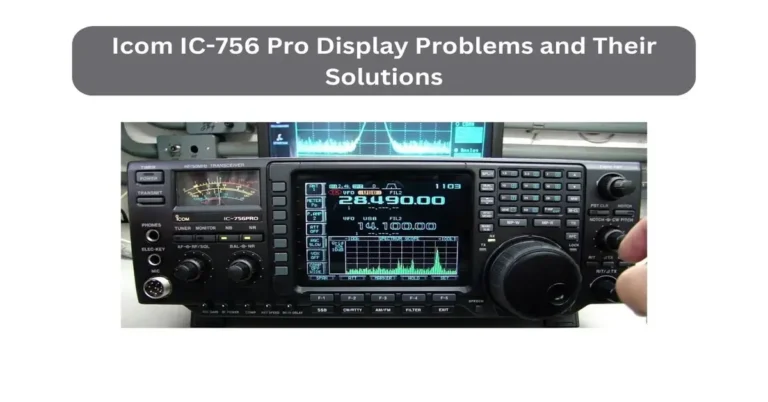5 Common Yaesu FT-920 Problems and Possible Fixes
The Yaesu FT-920 is a well-regarded HF/6m transceiver cherished by amateur radio enthusiasts for its robust design and reliable performance. However, like any sophisticated equipment, it is not immune to problems that may arise with prolonged use. Over time, even the most reliable transceivers can exhibit issues that frustrate users and disrupt communications. Whether you’re a seasoned operator or a newcomer, knowing how to troubleshoot common problems can save you time and money.
This guide will walk you through five common issues that users of the Yaesu FT-920 may encounter and provide possible fixes to get your transceiver back in top working condition. From power output inconsistencies to receiver sensitivity loss, we’ll cover various issues and offer practical solutions to help you maintain your transceiver’s performance.
1. Power Output Issues
Problem:
One of the most common issues faced by Yaesu FT-920 users is inconsistent or low power output. This problem can manifest in various ways, such as fluctuating transmission power, weaker-than-expected signals, or even a complete loss of output power. These issues can significantly hinder communication, making it difficult to maintain a stable connection with other operators.
Causes:
Several factors can lead to power output issues in the FT-920. Aging components, such as transistors or capacitors, can degrade over time, affecting the transceiver’s ability to maintain consistent power levels. Faulty connections, particularly in the power supply or antenna system, can also lead to intermittent power issues. Additionally, problems with the power supply itself, such as voltage drops or unstable current, can contribute to power inconsistencies.
Fixes:
To troubleshoot power output issues, start by checking the power supply. Ensure that it is providing a stable voltage within the transceiver’s required range. If possible, test the FT-920 with a different power supply to rule out power source issues. Next, examine all connections, particularly those related to the antenna system. Loose or corroded connectors can cause significant power losses, so ensure that all connections are secure and free from corrosion. If the problem persists, consider using a dummy load to test the transceiver’s output. This will help you determine whether the issue lies within the transceiver or the antenna system. If internal components such as transistors or capacitors are suspected to be the cause, it may be necessary to consult a professional technician for further diagnosis and repair.
Read More: 5 Common Yaesu FT 707 Problems and Possible Fixes
2. Audio Distortion
Problem:
Audio distortion is another common issue that can affect the Yaesu FT-920. Users may experience distorted or unclear audio during transmission or reception, leading to communication difficulties. Distortion can manifest as crackling sounds, muffled audio, or complete loss of clarity, making it challenging to understand or be understood by other operators.
Causes:
Several factors can contribute to audio distortion. A faulty or incompatible microphone can cause poor audio quality during transmission. RF interference from nearby electronic devices or other radio equipment can also distort the audio signal. Additionally, internal component degradation, such as issues with the audio amplifier or filters, can result in distorted audio.
Fixes:
To address audio distortion, begin by inspecting the microphone. Ensure that it is compatible with the FT-920 and that all connections are secure. If possible, test with a different microphone to see if the issue persists. Next, consider the possibility of RF interference. Ensure that the transceiver and its surroundings are properly grounded to minimize interference. Additionally, try relocating the transceiver or any nearby electronic devices that could be causing interference. If internal components are suspected to be the issue, such as the audio amplifier or filters, it may be necessary to have the transceiver serviced by a professional technician. In some cases, using an external audio filter or equalizer can help improve audio clarity.
Read More: 5 Common Yaesu FT-747 Problems and Possible Fixes
3. Frequency Drift
Problem:
Frequency drift is a problematic issue where the transceiver drifts off the set frequency during operation. This can cause significant disruptions during communication, as the operator must constantly adjust the frequency to stay in tune with the desired signal. Frequency drift can be particularly frustrating during long transmissions or when working with weak signals.
Causes:
Several factors can cause frequency drift in the FT-920. Temperature fluctuations can affect the stability of the oscillator, leading to drift. Aging oscillators or other frequency-determining components can also lose their precision over time, contributing to this problem. Additionally, voltage instability, whether due to an aging power supply or internal voltage regulation issues, can cause frequency drift.
Fixes:
To address frequency drift, start by ensuring that the transceiver is operating in a stable temperature environment. Avoid placing the FT-920 in areas where it is exposed to direct sunlight or near heat sources. If temperature fluctuations are unavoidable, consider adding a small fan to improve ventilation and stabilize the internal temperature. Next, recalibrate the oscillator if the option is available in the transceiver’s settings. If the oscillator or other frequency-determining components are aging, they may need to be replaced. Additionally, check the power supply for voltage stability. If the power supply is providing inconsistent voltage, it may need to be replaced or serviced. In some cases, using an external frequency reference can help maintain stability.
Read More: 5 Common Yaesu FRG-7700 Problems and Possible Fixes
4. Display Problems
Problem:
The display on the Yaesu FT-920 is crucial for monitoring frequency, mode, and other settings. However, some users may encounter issues with the display, such as fading, dimming, or complete failure. These problems can make it difficult to operate the transceiver effectively, especially in low-light conditions.
Causes:
A variety of factors can cause display problems. The most common issue is backlight failure, which can cause the display to become dim or unreadable. Aging display components, such as the LCD or associated circuitry, can also lead to display malfunctions. In some cases, power supply issues or faulty connections may contribute to display problems.
Fixes:
If the display is dim or fading, the first step is to check the backlight. The backlight may need to be replaced if it has failed. This is a relatively straightforward repair that can be done by a professional technician. If the entire display is malfunctioning, it may be necessary to inspect the connections between the display and the main circuit board. Loose or corroded connections can cause display issues, so ensure that all connections are secure and free from corrosion. If the display components themselves are aging, replacing the LCD or associated circuitry may be required. In some cases, a power supply issue may be affecting the display, so check the power supply for stability and consistency. If all else fails, consulting a professional technician for a more in-depth diagnosis and repair may be necessary.
Read More: 5 Common Yaesu 710 Problems and Possible Fixes
5. Receiver Sensitivity Loss
Problem:
Receiver sensitivity is critical for picking up weak signals and maintaining clear communication. Over time, some users may notice a decline in the FT-920’s receiver sensitivity, leading to weak or missing signals. This issue can significantly affect the transceiver’s performance, especially in challenging signal environments.
Causes:
Receiver sensitivity loss can be attributed to several factors. Aging components, such as RF amplifiers or filters, can degrade over time, reducing the transceiver’s ability to pick up weak signals. Antenna issues, such as poor connections or damage, can also contribute to reduced sensitivity. Additionally, problems with the RF front end, such as faulty transistors or capacitors, can cause sensitivity loss.
Fixes:
To address receiver sensitivity loss, start by checking the antenna system. Ensure that all connections are secure and that the antenna is in good condition. If possible, test with a different antenna to see if the issue is related to the antenna system. Next, consider the possibility of aging components within the transceiver. Replacing worn-out RF amplifiers or filters can help restore sensitivity. If the RF front-end is suspected to be the cause, it may be necessary to replace faulty transistors or capacitors. In some cases, using a preamplifier can help boost weak signals and improve overall sensitivity. However, if the issue persists, consulting a professional technician for a more thorough diagnosis and repair may be necessary.
Read More: 5 Common Yaesu 7250 Problems and Possible Fixes
Conclusion
In conclusion, while the Yaesu FT-920 is a reliable and well-regarded transceiver, it is not immune to the common issues that can arise with prolonged use. By understanding and addressing these problems, users can maintain their transceivers in optimal working conditions. Whether dealing with power output issues, audio distortion, frequency drift, display problems, or receiver sensitivity loss, the key is regular maintenance and prompt troubleshooting.
By following the tips and solutions provided in this guide, you can ensure that your FT-920 continues to perform at its best for years to come. If you’re unable to resolve any issues on your own, don’t hesitate to seek professional help. Keeping your equipment in good shape is essential for enjoying a seamless and satisfying amateur radio experience.






